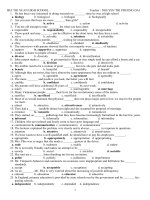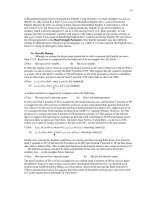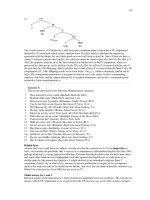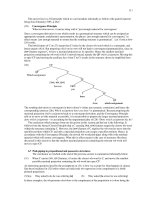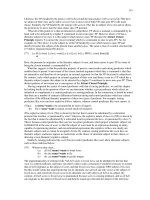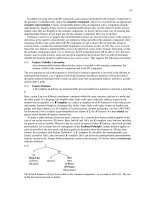Cú pháp tiếng anh part 11 pptx
Bạn đang xem bản rút gọn của tài liệu. Xem và tải ngay bản đầy đủ của tài liệu tại đây (97.99 KB, 10 trang )
101
(i) CP
C TP
ø
PRN T '
He
T VP
Tns
3SgPr
V PRN
help her
The overall clause is a CP headed by a null declarative complementiser ø which has a TP complement
headed by a T constituent which carries a present-tense Tns affix which is third person singular by
agreement with the subject he, and which needs an overt verb stem to attach to. Since T does not have a
strong V-feature in present-day English, the verb help cannot be raised to provide a host for the affix in T.
After the syntactic structure in (i) has been formed, it is handed over to the PF component, where it is
processed in a bottom-up, cyclic fashion. On the TP cycle, The Tns affix in T is lowered onto the end of
the verb help by Affix Hopping, which specifies that a weak affix in T is lowered onto the head V of a VP
complement of T. Affix Hopping results in the form [help+ Tns
3SgPr
], which is ultimately spelled out as
helps. The complement pronoun her is assigned accusative case in the syntax by the c-commanding
transitive verb help, and the subject pronoun he is assigned nominative case by the c-commanding null
intransitive finite complementiser ø.
_________________________________________________________________________________________________________________________________________________________________________________________
Exercise X
Discuss the derivation of the following Shakespearean sentences:
1 Thou marvell’st at my words (Macbeth, Macbeth, III.ii)
2 Macbeth doth come (Third Witch, Macbeth, I.iii)
3 He loves not you (Lysander, Midsummer Night’s Dream, III.ii)
4 You do not look on me (Jessica, Merchant of Venice, II.vi)
5 Wilt thou use thy wit? (Claudio, Much Ado About Nothing, V.i)
6 Wrong I mine enemies? (Brutus, Julius Caesar, IV.ii)
7 Knows he not thy voice? (First Lord, All's Well That Ends Well, IV.i)
8 Didst thou not say he comes? (Baptista, Taming of the Shrew, III.ii)
9 Canst not rule her? (Leontes, Winter's Tale, II.iii)
10 Hath not a Jew eyes? (Shylock, Merchant of Venice, III.i)
11 Do not you love me? (Benedick, Much Ado About Nothing, V.iv)
12 Buy thou a rope! (Antipholus, Comedy of Errors, IV.i)
13 Fear you not him! (Tranio, Taming of the Shrew, Iv.iv)
14 Speak not you to him! (Escalus, Measure for Measure, V.i)
15 Do not you meddle! (Antonio, Much Ado About Nothing, V.i)
16 She not denies it (Leonato, Much Ado About Nothing, IV.i)
Helpful hints
Assume that 9 has a null finite pro subject. Assume also that the sentences in 12-15 are imperative in
force, and consider the possibility that V raises to C in imperatives in Elizabethan English (See Han 2001),
perhaps attaching to a strong imperative affix Imp. Consider also the possibility that not had a dual status
and could either function as an independent word (like present-day English not) or could serve as an
enclitic particle (like present-day English n’t) which attached to an immediately adjacent finite T
constituent. Finally, say in what way(s) sentence 16 proves problematic in respect of the assumptions
made in the main text (and in the model answer below), and see if you can think of possible solutions (e.g.
What if the verb raised as far as NEG but not as far as T?).
Model answer for 1 and 2
Relevant aspects of the derivation of 1 (here presented in simplified form) are as follows. The verb marvel
merges with its PP complement at my words to form the VP marvel at my words. This in turn is merged
102
with a T constituent containing a present tense Tns affix to form the T-bar Tns marvel at my words, which
is in turn merged with its subject thou. The Tns affix agrees with thou and thus carries the features
[second-person, singular-number, present-tense], below abbreviated to 2SgPr. The resulting TP is merged
with a null intransitive finite C which marks the declarative force of the sentence and which assigns
nominative case to thou. 1 thus has the syntactic structure shown in simplified form in (i) below, with the
dotted arrow indicating movement of the verb marvel from V to T:
(i) CP
C TP
ø
PRN T '
thou
T VP
marvel+Tns
2SgPr
V PP
marvel at my words
The string marvel+Tns
2SgPr
is ultimately spelled out as marvell’st in the PF component.
Sentence 2 is derived as follows. The verb come merges with a weak Tns affix in T, forming the T-bar
Tns come. This will in turn be merged with its subject Macbeth, which we can take to be a DP headed by a
null determiner, in accordance with the DP hypothesis (and indeed, proper names in many languages can
be premodified by an overt determiner – cf. e.g. Italian la Callas, literally ‘the Callas’). Merging the
resulting DP with a null declarative complementiser will derive the syntactic structure shown in (ii) below:
(ii) CP
C TP
ø
DP T '
D N T V
ø Macbeth Tns come
It would seem that the Tns affix undergoes DO-support in the PF component, and is ultimately spelled out
as doth (which is a dialectal variant of does). What is surprising about this is that the dummy auxiliary do
is used only to support a Tns affix which is unable to find a host by any other means. So what we’d expect
to happen when the structure in (ii) is handed over to the PF component is for the Tns affix to be lowered
onto the verb come in the PF component by Affix Hopping, with the resulting verb being spelled out as
cometh (a dialectal variant of comes). However, this is clearly not what happens. Why not?
One possibility is that the Tns affix in a finite T in a structure like (ii) could be either strong or weak in
Elizabethan English. Where it is strong, the Tns affix will trigger raising of the main verb from V to T;
where it is weak, the verb will remain in situ, and the tense affix will remain unattached in the syntax. The
resulting structure (ii) will then be handed over to the PF component, where it is processed in a bottom-up
fashion. Although in present-day English Do-Support is only used where Affix Hopping cannot apply,
let’s suppose that in Shakespearean English the two are in free variation, in the sense that either can be
used as a way of providing a host for an unattached affix in T. Applying Affix Hopping will lower the
(third person singular present tense) affix in (ii) onto the verb deriving the string come+Tns
3SgPr
(which is
ultimately spelled out as cometh). Applying Do-Support instead will result in the dummy stem do being
attached to the Tns affix in T, so forming the string do+Tns
3SgPr
(which is ultimately spelled out as doth).
If an analysis along the lines outlined here is tenable, it implies that there was considerably more
morphosyntactic variation in Shakespearean English than we find in present-day varieties of Standard
English – for example, in respect of a finite Tns affix being either strong or weak, and an unattached Tns
affix either being lowered onto the verb, or having do attached to it. Given that Shakespeare’s writing
contains a mixture of different dialect forms (as we see from the alternation between dialectal variants like
comes/cometh and does/doth), this may not be implausible. However, as noted by Tieken-Boon van
Ostade (1988), the origin of do is ‘one of the great riddles of English linguistic history’.
103
6.
Wh-movement
6.1 Overview
In the previous chapter, we looked at the head movement operation by which a head can move
into the next highest head position within the structure containing it. In this chapter, we look at a very
different kind of movement operation traditionally termed wh-movement, by which a wh-expression like
who or what languages moves into the specifier position within CP. We begin by looking at the syntax of
wh-questions, and then go on to probe the syntax of two other types of wh-clause, namely exclamative
clauses and relative clauses.
6.2 Wh-questions
So far, we have implicitly assumed that CP comprises a head C constituent (which can be filled
by a complementiser or a preposed auxiliary) and a TP complement. However, one question which such
an analysis begs is what position is occupied by the bold-printed constituent which precedes the italicised
auxiliary in root interrogatives (i.e. main-clause questions) such as (1) below:
(1)(a) What languages can you speak? (b) Which one would you like?
(c) Who was she dating? (d) Where are you going?
Each of the sentences in (1) contains an italicised inverted auxiliary occupying the head C position of CP,
preceded by a bold-printed interrogative wh-expression – i.e. an expression containing an interrogative
word beginning with wh- like what/which/who/where/when/why. (Note that how in questions like How are
you? How well did he behave? etc. is also treated as a wh-word because it exhibits the same syntactic
behaviour as interrogative words beginning with wh ) Each of the wh-expressions in (1) functions as the
complement of the verb at the end of the sentence – as we see from the fact that each of the examples in
(1) has a paraphrase like that in (2) below in which the wh-expression occupies complement position after
the italicised verb: cf.
(2)(a) You can speak what languages? (b) You would like which one?
(c) She was dating who? (d) You are going where?
Structures like (2) are termed wh-in-situ questions, since the bold-printed wh-expression does not get
preposed, but rather remains in situ (i.e. ‘in place’) in the canonical position associated with its
grammatical function (e.g. what languages in (2a) is the direct object complement of speak, and
complements are normally positioned after their verbs, so what languages is positioned after the verb
speak). In English, wh-in-situ questions are used primarily as echo questions, to echo and question
something previously said by someone else – as we can illustrate in terms of the following dialogue:
(3) SPEAKER A: I just met Lord Lancelot Humpalot
SPEAKER B: You just met who?
Echo questions such as that produced by speaker B in (3) suggest that the wh-expressions in (1) originate
as complements of the relevant verbs, and subsequently get moved to the front of the overall clause. But
what position do they get moved into?
The answer is obviously that they are moved into some position preceding the inverted auxiliary. Since
inverted auxiliaries occupy the head C position of CP, let’s suppose that preposed wh-expressions are
moved into a position preceding the head C of CP. Given that specifiers are positioned before heads, a
plausible suggestion to make is that preposed wh-expressions move into the specifier position within CP
(= spec-CP). If so, a sentence like (2c) Who was she dating? will involve the arrowed movement
operations shown in (4) below:
104
(4) CP
PRN C '
Who
C TP
was
PRN T '
she
T VP
(1) was
V PRN
dating who
(2)
(To be more precise, interrogative pronouns like who are Q-pronouns and hence pronominal quantifiers.)
Two different kinds of movement operation (indicated by the numbered arrows) are involved in (4): the
movement arrowed in (1) involves the familiar operation of head movement by which the bold-printed
auxiliary was moves from the head T position of TP into the head C position of CP; by contrast (2)
involves movement of an italicised wh-expression from the complement position within VP into the
specifier position in CP, and this very different kind of movement operation is known as wh-movement.
Note that unlike head movement (which, as its name suggests, moves only heads), wh-movement moves
maximal projections; for instance, in (1a) What languages can you speak? wh-movement moves the
quantifier phrase what languages which is the maximal projection of the interrogative quantifier what? by
virtue of being the largest expression headed by the word what; and in (1c) Who was she dating? it moves
the interrogative Q-pronoun who (which is a maximal projection by virtue of being the largest expression
headed by the word who). Following Cheng (1997), we might suppose that every clause must be typed
(i.e. identified as declarative or interrogative etc. in type) in the syntax, and that a clause is typed as
interrogative if it contains an interrogative head or specifier: on this view, movement of the interrogative
pronoun who to spec-CP serves to type the CP in (4) as interrogative.
Evidence in support of the assumption that preposed wh-expressions move into spec-CP comes from
varieties of English in which a preposed wh-expression can precede a complementiser like that. This is
true, for example, of interrogative complement clauses like those bracketed below in Belfast English (from
Henry 1995, p.107):
(5)(a) I wonder [which dish that they picked]
(b) They didn’t know [which model that we had discussed]
Since the complementiser that occupies the head C position in the bracketed CP, it seems reasonable to
suppose that the wh-expressions which dish/which model in front of that occupy the specifier position
within CP, and this is what Alison Henry argues. (See Seppänen and Trotta 2000 and Zwicky 2002 for
discussion of the syntax of wh+that structures.)
6.3 Wh-movement as copying and deletion
A tacit assumption made in our analysis of wh-movement in (4) is that just as a moved head (e.g.
an inverted auxiliary) leaves behind a null copy of itself in the position out of which it moves, so too a
moved wh-expression leaves behind a copy at its extraction site (i.e. in the position out of which it is
extracted/moved). In earlier work in the 1970s and 1980s, moved constituents were said to leave behind a
trace in the positions out of which they move (informally denoted as t), and traces of moved nominal
constituents were treated as being like pronouns in certain respects. A moved constituent and its trace(s)
were together said to form a (movement) chain, with the highest member of the chain (i.e. the moved
constituent) being the head of the movement chain, and the lowest member being the foot of the chain.
Within the framework of Chomsky’s more recent copy theory of movement, a trace is taken to be a full
copy (rather than a pronominal copy) of a moved constituent. Informally, however, we shall sometimes
refer to the null copies left behind by movement as traces or trace copies in later sections and chapters.
105
The assumption that moved wh-expressions leave a copy behind can be defended not only on
theoretical grounds (in terms of our desire to develop a unified theory of movement in which both minimal
and maximal projections leave behind copies when they move), but also on empirical grounds. One
relevant piece of empirical evidence that wh-movement involves a copying operation comes from
sentences such as those below:
(6)(a) What hope of finding survivors could there be?
(b) What hope could there be of finding survivors?
(7)(a) What proof that he was implicated have you found?
(b) What proof have you found that he was implicated?
In order to try and understand what’s going on here, let’s take a closer look at the derivation of (6). The
expression what hope of finding survivors is a QP comprising the quantifier what and an NP complement
which in turn comprises the noun hope and its PP complement of finding survivors. The overall QP what
hope of finding survivors is initially merged as the complement of the verb be, but ultimately moves to the
front of the overall sentence in (6a): this is unproblematic, since it involves wh-movement of the whole
QP. But in (6b), it would seem as if only part of this QP (= the string what hope) undergoes
wh-movement, leaving behind the PP of finding survivors. The problem with this is that the string what
hope is not a constituent, only a subpart of the overall QP what hope of finding survivors. Given the
standard assumption that only complete constituents can undergo movement, we clearly cannot maintain
that the non-constituent string what hope gets moved on its own. So how can we account for sentences
like (6b)? Copy theory provides us with an answer, if we suppose that wh-movement places a copy of the
complete QP what hope of finding survivors at the front of the overall sentence, so deriving the structure
shown in skeletal form in (8) below:
(8) What hope of finding survivors could there be what hope of finding survivors
If we further suppose that the PP of finding survivors is spelled out in its original position (i.e. in the
italicised position it occupied before wh-movement applied) but the remaining constituents of the QP (the
quantifier what and the noun hope) are spelled out in the superficial (bold-printed) position in which they
end up after wh-movement, (6b) will have the superficial structure shown in simplified form below after
copy-deletion has applied (with strikethrough indicating constituents which receive a null spellout):
(9) What hope of finding survivors could there be what hope of finding survivors
As should be obvious, such an analysis relies crucially on the assumption that moved constituents leave
behind full copies of themselves. It also assumes the possibility of split spellout/discontinuous spellout,
in the sense that (in sentences like (6/7) above) a PP or CP which is the complement of a particular type of
moved constituent can be spelled out in one position (in the position where it originated), and the
remainder of the constituent spelled out in another (in the position where it ends up). More generally, it
suggests that (in certain structures) there a choice regarding which part of a movement chain gets deleted
(an idea developed in Bobaljik 1995, Brody 1995, Groat and O’Neil 1996, Pesetsky 1997/1998, Richards
1997, Roberts 1997, Runner 1998, Nunes 1999, Cormack and Smith 1999, and Bošković 2001). A further
possibility which this opens up is that wh-in-situ structures may involve a moved wh-expression being
spelled out in its initial position (at the foot of the movement chain) rather than in its final position (at the
head of the movement chain): see Pesetsky (2000) and Reintges, LeSourd and Chung (2002) for analyses
of this ilk, and Watanabe (2001) for a more general discussion of wh-in-situ structures.
Further evidence that wh-movement leaves behind a copy which is subsequently deleted comes from
speech errors involving wh-copying, e.g. in relative clauses such as that bracketed below:
(10) It’s a world record [which many of us thought which wasn’t on the books at all] (Athletics
commentator, BBC2 TV)
What’s the nature of the speech error made by the tongue-tied (or brain-drained) BBC reporter in (10)?
The answer is that when moving the relative pronoun which from its initial italicised position to its
subsequent bold-printed position, our intrepid reporter successfully merges a copy of which in the
bold-printed position, but fails to delete the original occurrence of which in the italicised position. Such
speech errors provide us with further evidence that wh-movement is a composite operation involving both
copying and deletion.
106
A different kind of argument in support of positing that a moved wh-expression leaves behind a null
copy comes from the semantics of wh-questions. Chomsky (1981, p.324) argues that a wh-question like
(11a) below has a semantic representation (more precisely, a Logical Form/LF representation) which
can be shown informally as in (11b) below, with (11b) being paraphraseble as ‘Of which x (such that x is a
person) is it true that she was dating x?’:
(11)(a) Who was she dating? (b) Which x (x a person), she was dating x
In the LF representation (11b), the quantifier which functions as an interrogative operator which serves
to bind the variable x. Since a grammar must compute a semantic representation for each syntactic
structure which it generates/forms, important questions arise about how syntactic representations are to be
mapped/converted into semantic representations. One such question is how a syntactic structure like (11a)
can be mapped into an LF-representation like (11b) containing an operator binding a variable. If a moved
wh-expression leaves behind a copy, (11a) will have the syntactic structure shown in highly simplified
form in (12) below (where who is a null trace copy of the preposed wh-word who):
(12) Who was she dating who?
(See (4) above for a fuller representation of the relevant structure.) The LF-representation for (11a) can be
derived from the syntactic representation (12) in a straightforward fashion if the copy who in (12) is given
an LF interpretation as a variable bound by the wh-quantifier which.
A further semantic argument in support of the copy theory of movement is formulated by Chomsky
(1995) in relation to the interpretation of sentences such as:
(13) Joe wonders which picture of himself Jim bought
In (13), the reflexive anaphor himself can refer either to Joe or to Jim. An obvious problem posed by the
latter interpretation is that a reflexive has to be c-commanded by a local antecedent (one contained within
the same TP, as we saw in §3.7), and yet Jim does not c-command himself in (13). How can we account
for the dual interpretation of himself? Chomsky argues that the copy theory of movement provides a
principled answer to this question. The QP which picture of himself is initially merged as the complement
of the verb bought but is subsequently moved to front of the bought clause, leaving behind a copy in its
original position, so deriving the structure shown in skeletal form in (14) below:
(14) [
CP
[
TP
Joe wonders [
CP
which picture of himself [
TP
Jim bought which picture of himself]]]]
Although the italicised copy of the QP which picture of himself gets deleted in the PF component,
Chomsky argues that copies of moved constituents remain visible in the semantic component, and that
binding conditions apply to LF representations. If (14) is the LF representation of (13), the possibility of
himself referring to Jim can be attributed to the fact that the italicised occurrence of himself is
c-commanded by (and contained within the same TP as) Jim in the relevant LF-representation. On the
other hand, the possibility of himself referring to Joe can be attributed to the fact that the bold-printed
occurrence of himself is c-commanded by (and occurs within the same TP as) Joe.
In this section, we have seen that there is a range of empirical evidence which supports the claim that a
constituent which undergoes wh-movement leaves behind a copy at its extraction site. This copy is
normally given a null spellout in the PF component, though we have seen that copies may sometimes have
an overt spellout, or indeed part of a moved phrase may be spelled out in one position, and part in another.
We have also seen that copies of moved wh-constituents are visible in the semantic component, and play
an important role in relation to the interpretation of anaphors.
6.4 Wh-movement and EPP
An important question raised by the analysis outlined above is what triggers wh-movement.
Chomsky (1998, 1999, 2001) suggests that an [EPP] feature is the mechanism which drives movement of
wh-expressions to spec-CP. More specifically, he maintains that just as T in finite clauses carries an [EPP]
feature requiring it to be extended into a TP projection containing a subject as its specifier, so too C in
wh-questions carries an [EPP] feature requiring it to be extended into a CP projection containing a
wh-expression as its specifier.
We can illustrate how the EPP analysis of wh-movement works by looking at the derivation of the
bracketed interrogative complement clause in (15) below:
107
(15) He wants to know [where you are going]
The bracketed wh-question clause in (15) is derived as follows. The verb going is merged with its
complement where to form the VP going where. The present tense auxiliary are is then merged with the
resulting VP to form the T-bar are going where. The pronoun you is in turn merged with this T-bar to
form the TP you are going where. A null complementiser [
C
ø] is subsequently merged with the resulting
TP. Since the relevant clause is a wh-question, C contains a [WH] feature. In addition, since English
(unlike Chinese) is the kind of language which requires wh-movement in ordinary wh-questions, C also
has an [EPP] feature requiring it to have a specifier. Accordingly, merging C with its TP complement will
form the C-bar in (16) below (features being CAPITALISED and enclosed in square brackets):
(16) C '
C TP
[WH, EPP]
ø
PRN T '
you
T VP
are
V PRN
going where
(A minor descriptive detail is that the locative adverbial pronoun where is here categorised here as a
PRN/pronoun, though could equally be assigned to the category ADV/adverb.) The [WH] feature of C
allows C to attract a wh-expression. The [EPP] feature of C requires C to project as its specifier an
expression which has a feature which matches some feature of C: since C carries a [WH] feature, this
amounts to a requirement that C must project a wh-specifier. On the assumption that the wh-pronoun
where carries a [WH] feature, this means that C will attract the wh-pronoun where to move from the VP-
complement position which it occupies in (16) above to CP-specifier position. If we suppose that the [WH]
and [EPP] features carried by C are deleted (and thereby inactivated) once their requirements are satisfied
(deletion being indicated by strikethrough), we derive the structure (17) below (assuming, too, that the
phonological features of the trace of the moved wh-constituent where are also deleted):
(17) CP
PRN C '
where
C TP
[WH, EPP]
ø PRN T '
you
T VP
are
V PRN
going where
There is no auxiliary inversion (hence no movement of the auxiliary are from T to C) because (17) is a
complement clause, and an interrogative C does not carry a [TNS] feature triggering auxiliary inversion in
complement clauses.
By contrast, main-clause wh-questions involve auxiliary inversion as well as wh-movement, as we see
from sentences like (18) below:
(18) Who were you phoning?
Let’s suppose that the derivation of (18) proceeds as follows. The wh-pronoun who merges with the verb
phoning to form the VP phoning who. The resulting VP is subsequently merged with the past tense
auxiliary were to form the T-bar were phoning who, which is itself merged with the pronoun you to form
the TP you were phoning who. This TP is then merged with a null interrogative C. Since (18) is a
108
wh-question, C will carry a [WH] feature and an [EPP] feature. Since (18) is also a main-clause question, C
will additionally carry a [TNS] feature which triggers movement of a tensed auxiliary from T to C. Given
these assumptions, merging C with the TP you were phoning who will derive the following structure:
(19) C '
C TP
[TNS, WH, EPP]
ø PRN T '
you
T VP
were
V PRN
phoning who
The [TNS] feature of C attracts the present-tense auxiliary have to move to C (attaching to a null question
affix in C). The [WH, EPP] features of C require C to have a wh-expression as its specifier, and hence
trigger movement of the wh-pronoun who to spec-CP, so deriving the structure shown below:
(20) CP
PRN C '
Who
C TP
[TNS, WH, EPP]
were+ø PRN T '
you
T VP
were
V PRN
phoning who
And (20) is the superficial syntactic structure of (18) Who were you phoning?
Chomsky (2001) maintains that movement is simply another form of merger. He refers to merger
operations which involve taking an item out of the lexical array and merging it with some other
constituent as external merge, and to movement operations by which an item contained within an existing
structure is moved to a new position as internal merge. Accordingly, the structure (19) is created by a
series of external merger operations, and is then mapped into (20) by two internal merger operations
(namely head-movement and wh-movement).
6.5 Attract Closest Principle
The EPP analysis of wh-movement outlined in the previous section has interesting implications
for the syntax of multiple wh-questions which contain two or more separate wh-expressions. (See Dayal
2002 for discussion of the semantic properties of such questions.) A salient syntactic property of such
questions in English is that only one of the wh-expressions can be preposed – as we can illustrate in
relation to an echo question such as:
(21) He might think who has done what?
If we try and prepose the highlighted wh-words in (21), we find that only one of the two can be preposed
(not both of them), and moreover the preposed item has to be who and not what:
(22)(a) Who might he think has done what? (b) *What might he think who has done?
(c) *Who what might he think has done? (d) *What who might he think has done?
109
Why should this be? In order to get a clearer idea of what’s going on where, consider what happens when
we reach the stage of derivation shown below:
(23) C '
C TP
[TNS, WH, EPP]
ø PRN T '
he
T VP
might
V CP
think
C TP
ø
PRN T '
who
T VP
has
V PRN
done what
The affixal [TNS] feature carried by the main-clause C at the top of the tree attracts the auxiliary might to
move from T to C. The [WH, EPP] features of C in turn mean that the topmost C attracts a wh-expression to
move to spec-CP. But (23) contains two wh-words, namely who and what. Since it is who rather than what
which must be preposed in (21) and since who is closer to C than what, let’s suppose that C attracts the
closest wh-word which it c-commands. This requirement is a consequence of a principle of Universal
Grammar (adapted from Chomsky 1995, p.297) which we can outline informally as follows:
(24) Attract Closest Principle/ACP
A head which attracts a given kind of constituent attracts the closest constituent of the relevant kind
Since who is closer to the main-clause C than what in (23), it follows from ACP that C attracts who to
move into spec-CP, so deriving the structure shown in simplified form below:
(25) CP
PRN C '
who
C TP
[TNS WH, EPP]
might+ø PRN T '
he
T VP
might
V CP
think ø who has done what
As before, we assume that wh-movement and head movement lead to deletion of the [TNS, WH, EPP]
features of C, and of the trace copies of the moved constituents who and might. In short, the assumption
that C carries [WH, EPP] features which attract a wh-expression to move to spec-CP, in conjunction with
the Attract Closest Principle (24) and the ancillary assumption that the [EPP] and [WH] features of C are
deleted (and thereby inactivated) once a wh-expression has been moved to spec-CP, accounts for the
pattern of grammaticality found in multiple wh-questions like (22).
110
6.6 Pied-piping and convergence
Most of the wh-questions we have analysed so far have involved movement of a wh-word to
spec-CP. However, sometimes it’s more than just a wh-word which gets preposed under wh-movement.
For example, if we look at the wh-movement counterpart of a wh-in-situ question like (26a) below, we
find that when the wh-quantifier which is moved to the front of the sentence, the noun assignment has to
be moved together with it:
(26)(a) You have done which assignment?
(b) *Which have you done assignment?
(c) Which assignment have you done?
To use the relevant technical term, when a wh-quantifier is moved to spec-CP, its complement has to be
pied-piped (i.e. dragged) along with it, so that the whole quantifier phrase which assignment moves to
spec-CP – as in (26c). (The pied-piping metaphor was coined by Ross 1967, based on a traditional fairy
story in which the pied-piper in the village of Hamelin enticed a group of children to follow him out of a
rat-infested village by playing his pipe.) Why should this be? In order to try and answer this question, let’s
consider how (26c) is derived.
The quantifier which merges with the noun assignment to form the QP which assignment. This in turn
is merged with the verb done to form the VP done which assignment. The resulting VP is subsequently
merged with the present tense auxiliary have to form the T-bar have done which assignment, which is
itself merged with the pronoun you to form the TP you have done which assignment. TP is then merged
with a null interrogative C. Since (26c) is a main-clause wh-question, C will carry [TNS, WH, EPP] features.
Consequently, merging C with the TP you have done which assignment will derive the following structure:
(27) C '
C TP
[TNS, WH, EPP]
ø PRN T '
you
T VP
have
V QP
done
Q N
which assignment
The [TNS] feature of C attracts the present-tense auxiliary have to move to C, attaching to the null question
affix in C. Given the Attract Closest Principle (24), the [WH, EPP] features of C attract the closest wh-word
to move to the specifier position within CP. The closest wh-word to C in (27) – and indeed the only
wh-word contained in (27) – is the wh-quantifier which. However, a specifier position is a position which
can only be occupied by a maximal projection. Because which is the head Q of QP (and so not a maximal
projection), which cannot move on its own to spec-CP. Instead, let’s suppose that C triggers movement of
a maximal projection containing a wh-word. Since the QP which assignment is a maximal projection
containing a wh-word (by virtue of being the largest expression headed by the wh-quantifier which), we
therefore correctly predict that C can trigger movement of the QP which assignment to spec-CP, so
deriving the structure associated with (26c) Which assignment have you done?
But the situation is not quite as straightforward as we might have hoped. After all, the VP done which
assignment is also a maximal projection containing a wh-word, since it is the maximal projection of the
verb done and contains the wh-word which. And yet C can’t trigger movement of the VP done which
assignment to spec-CP in (27), as we see from the ungrammaticality of:
(28) *Done which assignment has he?
So how come the QP which assignment can undergo wh-movement, but not the VP done which
assignment, when both are maximal projections containing the wh-word which?
